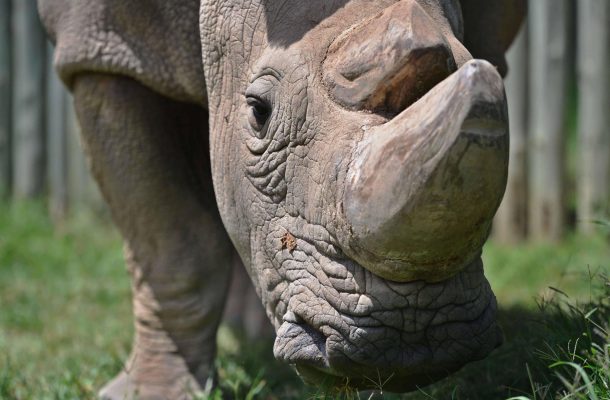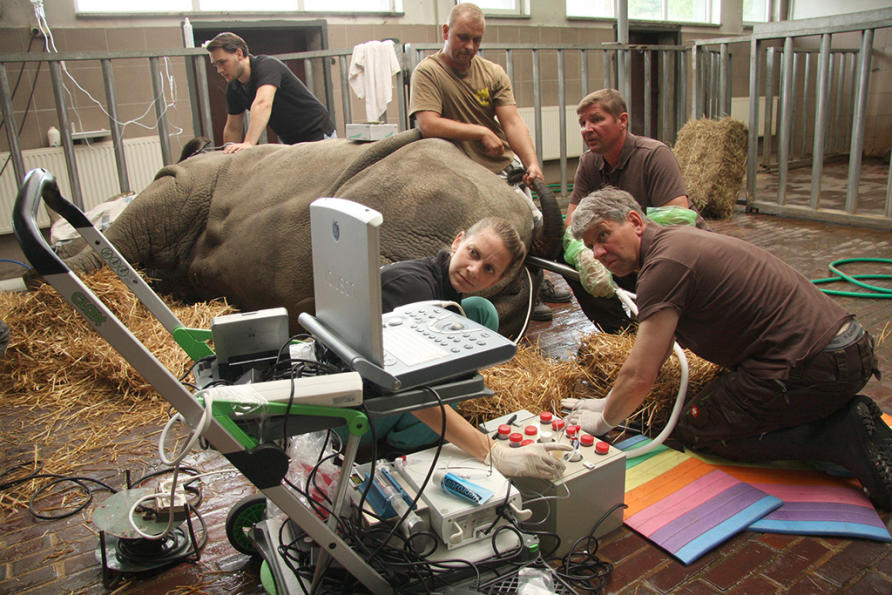Saving the northern white rhino from ‘extinction’

When Sudan, the last surviving male northern white rhino in the world, died in Kenya in March 2018, the species was as good as extinct. The two remaining female northern white rhinos, who are infertile, were doomed to live out their lives as the last of their kind.
Except maybe they won’t be the last.
Science has stepped in with a possible lifeline for the northern white rhino (NWR) and other critically endangered large mammals, according to new research published in Nature Communications.
An international team of researchers using assisted reproductive technologies (ART) has combined eggs from the southern white rhino (SWR) with the cryopreserved sperm of a northern white rhino to create viable embryos and embryonic stem cells.
There are five steps needed to get to the stage where we see a live birth of a hybrid northern-southern white rhino, and Professor Marilyn Renfree, from the School of BioSciences at the University of Melbourne, who was part of the team that developed the embryos, says the first step – harvesting eggs and sperm – was one of the most challenging.
Based on the lack of males, sperm would seem to be a major stumbling block, but forward-thinking researchers had already collected and stored sperm from four northern white rhinos.
“Over the past few years, the sperm from three bulls was sampled and put in cryopreservation. Samples were also taken from Sudan after his death and frozen,” says Professor Renfree.
It was the eggs that were more difficult to collect. Professor Renfree says the key to the project was new technology developed by Professor Thomas Hildebrandt, who’s based at the Leibniz-Institut in Berlin, that for the first time allowed collection of eggs from the ovaries of rhinoceroses.
“He designed an ovum pick-up (OPU) device. This has never been done before with such a large animal,” Professor Renfree says.
“Rhinos are very large (2,000 kg on average), so they have a reproductive tract that is very hard to access. Professor Hildebrandt developed a 150 centimetre-long OPU device to guide the needle to the correct place using a trans-rectal route.”
“They showed that oocytes can be repeatedly recovered from live females by this trans-rectal ovum pick-up, matured, fertilised by intracytoplasmic sperm injection (ICSI) and, for the first time, developed to the blastocyst stage in vitro.”
 Professer Hildebrandt, right front, and his team extracting eggs from a southern white rhino using a newly developed ovum pick-up device.
Professer Hildebrandt, right front, and his team extracting eggs from a southern white rhino using a newly developed ovum pick-up device.
The device developed by Professor Hildebrandt, who is also an Honorary Professor at the University of Melbourne and lead author of the paper, is currently awaiting patent approval and could also be used to collect eggs from other large mammals.
The southern white rhinoceros is a subspecies of the white rhino and its population is currently rated as ‘near threatened’ by the IUCN Red List of Threatened Species, with about 21,000 individuals remaining.
It is also resident in several zoos around the world. Professor Hildebrandt and his team were able to collect viable eggs from both southern and from the remaining two female northern white rhinos.
The next step in the process was bringing the eggs to maturity, which was done under laboratory conditions, in much the same way as the eggs of many other species, including humans.
Step three is the in vitro fertilisation of the egg with the sperm. Understandably, given the lack of living subjects, the northern white rhino sperm were not the highest quality.
“The northern white rhino sperm, when they were thawed out, were not very good and had to be activated by an electrical stimulus,” says Professor Renfree.
Once fertilisation occurred, forming a zygote, the team stimulated the growth of the zygote for between seven and twelve days, to the developmental stage called a blastocyst – at which point it is ready to be implanted in the uterus.
“The SWR and SWR x NWR hybrid embryos created by the team led by Professor Cesare Galli, who’s the senior author from the Italian reproductive laboratory Avantea, were very high quality and the stem cells created from two of them expressed all of the genes you’d expect them to express,” says Professor Renfree.
Two of the blastocysts have now been cryopreserved and these frozen embryos could soon be implanted into a southern white rhino surrogate to produce a baby hybrid rhino; preserving at least some of the unique genetics of its northern cousin.
Professor Renfree says the stem cells could hold the key to the survival of the rhinos, and other endangered species.
“The embryonic stem cells which are viable are potential candidates to create artificial gametes, both eggs and sperm, using a technique now being developed in mice.”
“If we could create a protocol for creating rhino gametes from stem cells, this is the most promising way forward.”
Now that Professor Hildebrandt and his team have perfected the technique for egg retrieval from rhinos, they have started work to produce a pure northern white rhino embryo.
“The team is going to harvest additional oocytes (immature eggs) from the last two female northern white rhinos who are currently in Kenya,” she says.
“They are infertile and never produced offspring, but they do have oocytes and these could be grown up in culture.”
She says this research also has the potential to help other large mammal species.
“This is a proof of concept project. These techniques have the potential to help the other endangered rhino species, including the Sumatran rhino and the Indian rhino and and other large mammals such as the Gaur, a large Asian cow that is also at risk of extinction.”
This article was published by Pursuit.
Daryl Holland has a PhD from the University of Bristol and spent 10 years researching algal blooms. He now edits the Science Matters channel of Pursuit, Melbourne University’s online research magazine. He has written for Crikey and ABC Online, and won the 2015 Ossie award for Investigative Journalism (Group).















